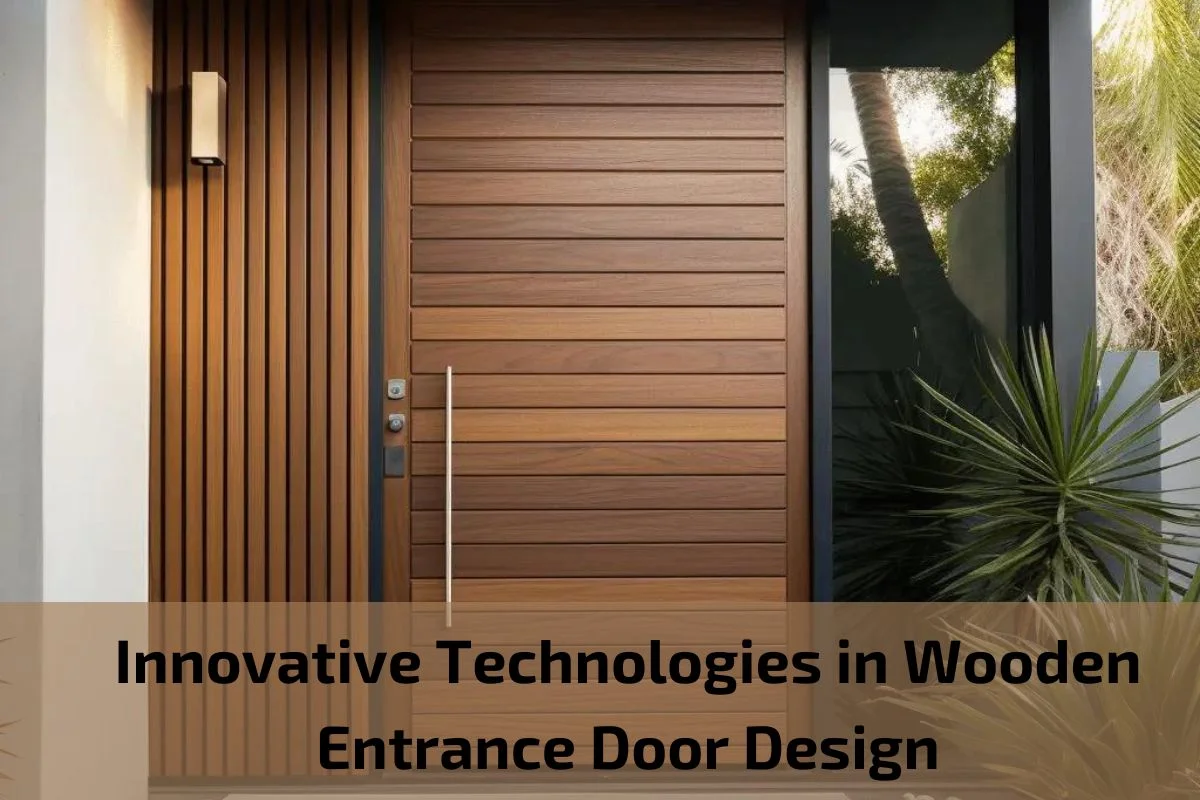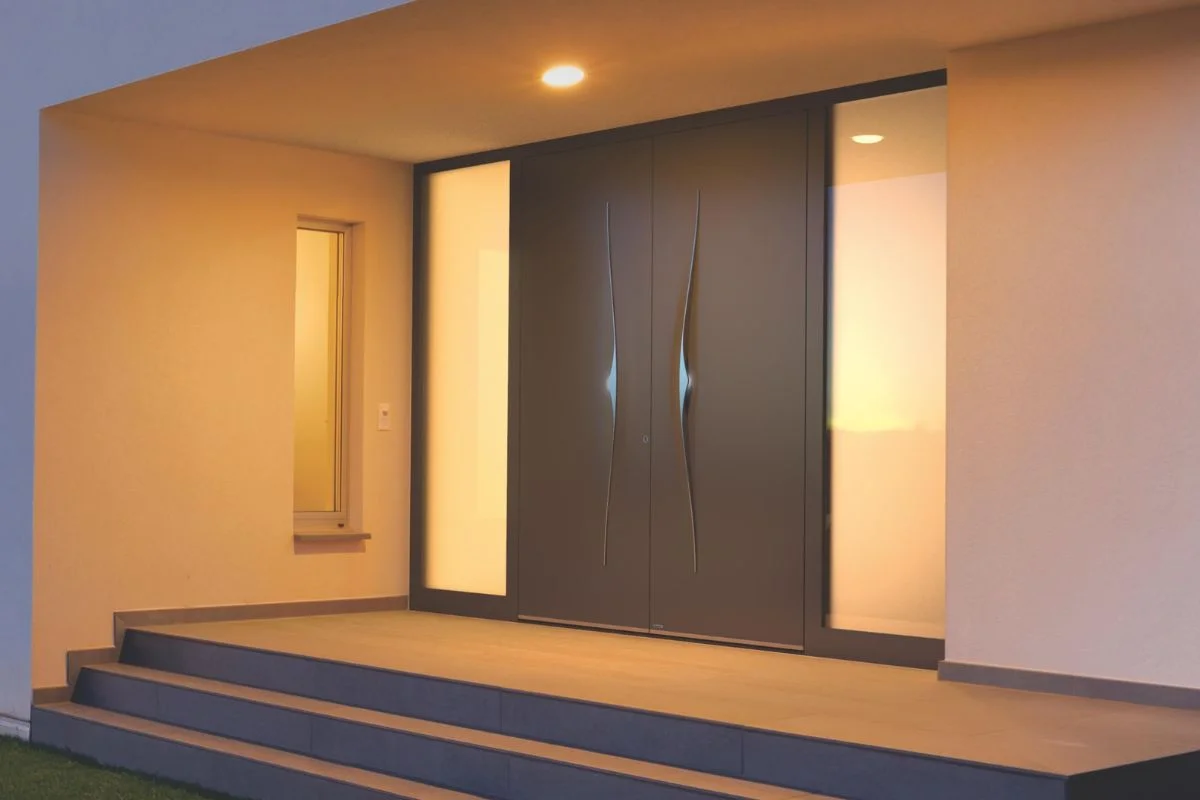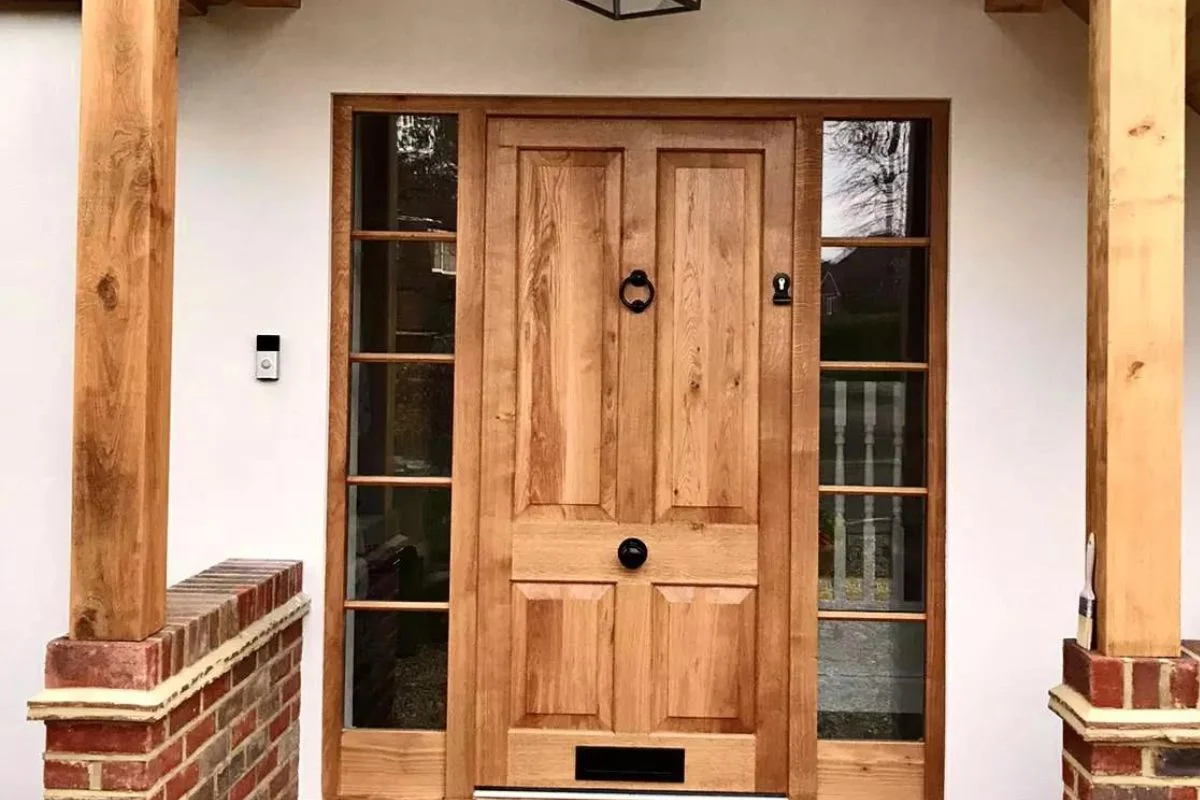
Innovative technologies have revolutionized various aspects of home design, and wooden entrance doors are no exception. Gone are the days when doors merely served as functional barriers between indoor and outdoor spaces. Today, wooden entrance doors are infused with cutting-edge technologies that enhance security, energy efficiency, and convenience while adding a touch of modernity to traditional craftsmanship.
In this article, we delve into the realm of innovative technologies in wooden entrance door design, exploring the latest advancements that are shaping the way we think about entryways. From smart locking systems to energy-efficient materials, manufacturers are pushing the boundaries of creativity and engineering to deliver doors that not only protect homes but also elevate their aesthetic appeal.
Join us as we journey through the realm of wooden entrance door technologies, uncovering the features and benefits that are transforming the way homeowners interact with and perceive their entry points. Whether you’re renovating an existing home or building a new one, understanding the innovations in wooden entrance door design will inspire you to rethink the possibilities and embrace the future of home entryways.
Importance of Entrance Wooden Entrance Doors in Home Design
Wooden entrance doors play a pivotal role in home design, serving as the gateway to our personal sanctuaries and setting the tone for the overall aesthetic of our residences. Their significance extends beyond mere functionality, encompassing elements of security, style, and curb appeal. Here are several reasons why wooden entrance doors are integral to home design:
First Impressions:
- Wooden entrance doors are the focal point of a home’s exterior and often the first feature visitors encounter. As such, they contribute significantly to the initial impression guests form about the property and its inhabitants.
- A well-crafted wooden door can convey a sense of warmth, elegance, and hospitality, inviting guests to step inside and explore further.
Architectural Character:
- Wooden entrance doors have the power to enhance the architectural character of a home, whether it’s a cozy cottage, a modern masterpiece, or a stately mansion.
- They serve as architectural elements that complement the overall design theme, adding charm, personality, and visual interest to the façade.
Curb Appeal:
- The exterior appearance of a home greatly influences its curb appeal and resale value. Wooden entrance doors contribute to the curb appeal by enhancing the overall aesthetic appeal and making the property more attractive to potential buyers.
- A well-designed wooden door can elevate the exterior aesthetics, creating a welcoming ambiance and increasing the perceived value of the home.
Security and Safety:
- In addition to their aesthetic appeal, wooden entrance doors provide a crucial layer of security and safety for homeowners and their families.
- Solid wood construction offers durability and resistance against forced entry, while sturdy locks and hardware provide peace of mind and protection against intruders.
- Moreover, wooden doors offer insulation against noise and weather elements, creating a comfortable and secure environment inside the home.
Personalization and Customization:
- Wooden entrance doors offer endless possibilities for personalization and customization to suit individual preferences and architectural styles.
- Homeowners can choose from a variety of wood species, finishes, stains, and decorative elements to create a door that reflects their unique taste and lifestyle.
- Whether it’s a classic panel design, a rustic farmhouse style, or a contemporary pivot door, wooden entrance doors can be tailored to fit any aesthetic vision.
Connection with Nature:
- Wood is a natural material that resonates with the human spirit and creates a sense of connection with the outdoors.
- Wooden entrance doors bring the beauty of nature into the home, infusing interiors with warmth, texture, and organic appeal.
- They serve as a bridge between the interior and exterior environments, blurring the boundaries and fostering a deeper connection with the natural world.
Overview of Wooden Entrance Doors
Wooden entrance doors stand as timeless symbols of craftsmanship, elegance, and security in home design. Crafted from natural wood materials, these doors offer a blend of aesthetic appeal, durability, and functionality that has made them a staple feature of residential architecture for centuries. Here’s an overview of wooden entrance doors, highlighting their key characteristics and attributes:
Natural Material:
- Wooden entrance doors are crafted from a variety of wood species, each offering unique grain patterns, colors, and textures. Common wood species used for entrance doors include oak, mahogany, cherry, maple, and fir.
- The natural beauty of wood adds warmth and character to the home’s exterior, creating a welcoming ambiance that reflects the homeowner’s connection with nature.
Solid Construction:
- Wooden entrance doors are renowned for their solid construction and durability. They are typically constructed with thick, solid wood panels or engineered wood cores, providing strength and stability against the elements.
- The thickness of the door panels, combined with high-quality hardware and locking mechanisms, enhances security and ensures long-term performance.
Design Versatility:
- One of the most appealing aspects of wooden entrance doors is their design versatility. They are available in a wide range of styles, including panel doors, French doors, Dutch doors, and custom-designed options.
- Homeowners can choose from various architectural details, such as raised panels, glass inserts, sidelights, and decorative accents, to create a door that complements the home’s architectural style and aesthetic preferences.
Customization Options:
- Wooden entrance doors offer extensive customization options, allowing homeowners to personalize every aspect of their door design.
- From selecting the wood species and finish to choosing hardware, glass options, and decorative elements, homeowners can create a door that reflects their individual taste and lifestyle.
Energy Efficiency:
- Wooden entrance doors provide excellent insulation properties, helping to regulate indoor temperatures and reduce energy costs.
- The natural density and thermal properties of wood help to minimize heat transfer and maintain a comfortable indoor environment year-round.
Maintenance Requirements:
- While wooden entrance doors require regular maintenance to preserve their beauty and performance, proper care can extend their lifespan and enhance their durability.
- Maintenance tasks may include periodic cleaning, sanding, refinishing, and sealing to protect the wood from moisture, UV exposure, and wear.
Longevity and Timelessness:
- Wooden entrance doors are prized for their longevity and timelessness, with many doors lasting for decades or even centuries with proper care.
- Their enduring appeal transcends changing design trends, making them a worthwhile investment that adds value to the home and enhances its curb appeal.

Advantages and Disadvantages of Wooden Entrance Doors
Wooden entrance doors offer numerous advantages, but they also come with some disadvantages. It’s important for homeowners to consider both aspects before making a decision. Let’s explore the advantages and disadvantages of wooden entrance doors:
Advantages:
Natural Beauty: Wooden entrance doors boast natural beauty and warmth that adds character to any home. The rich grain patterns and textures of wood create an inviting and aesthetic appeal.
Customization: Wooden doors offer extensive customization options. Homeowners can choose from various wood species, finishes, and designs to match their architectural style and personal preferences.
Durability: High-quality wooden entrance doors are durable and long-lasting. With proper maintenance, they can withstand the elements and provide reliable security for many years.
Insulation: Wood is a natural insulator, providing excellent thermal and sound insulation properties. Wooden doors help maintain indoor temperatures and reduce energy costs.
Reparability: Wooden entrance doors are relatively easy to repair and refinish. Minor scratches, dents, or blemishes can be sanded and refinished to restore the door’s appearance.
Disadvantages:
Maintenance: Wooden doors require regular maintenance to preserve their appearance and performance. This includes periodic cleaning, sealing, and refinishing to protect against moisture, rot, and pests.
Cost: High-quality wooden entrance doors can be expensive compared to other materials like steel or fiberglass. The cost of wood and craftsmanship may make wooden doors less budget-friendly for some homeowners.
Susceptibility to Damage: Wood is susceptible to damage from moisture, rot, and pests if not properly maintained. Exposure to harsh weather conditions or neglect can lead to warping, swelling, or decay of the wood.
Security Concerns: While wooden doors can provide adequate security, they may be more vulnerable to forced entry compared to steel or fiberglass doors. Reinforced hardware and locking mechanisms are essential for enhancing security.
Environmental Impact: The production of wooden doors may have environmental implications, especially if sourced from unsustainable forestry practices. Homeowners should consider choosing wood certified by sustainable forestry organizations.
Types and Designs of Wooden Entrance Doors
Wooden entrance doors come in a variety of types and designs, each offering unique features and aesthetic appeal. From classic panel doors to modern pivot designs, homeowners can choose the perfect wooden entrance door to complement their home’s architecture and style. Here are some common types and designs of wooden entrance doors:
Panel Doors:
- Panel doors are one of the most traditional and popular types of wooden entrance doors. They feature multiple panels framed by rails and stiles, creating a classic and timeless look.
- Panel doors can have various configurations, including raised panels, flat panels, and recessed panels, offering flexibility in design and style.
French Doors:
- French doors add elegance and sophistication to any home with their double-door design and large glass panels.
- These doors typically consist of two wooden panels hinged on opposite sides, allowing them to swing inward or outward. They are ideal for creating a seamless transition between indoor and outdoor spaces.
Dutch Doors:
- Dutch doors are characterized by their unique split design, which allows the top and bottom halves to open and close independently.
- These doors are both practical and charming, offering ventilation and security while maintaining privacy. They are often used in kitchens, nurseries, and mudrooms.
Carved Doors:
- Carved wooden doors feature intricate designs, patterns, and motifs carved into the wood surface.
- These doors add a touch of artistry and craftsmanship to the home’s entrance, making a bold statement and serving as a focal point of architectural interest.
Modern Designs:
- Modern wooden entrance doors are characterized by clean lines, minimalist aesthetics, and sleek finishes.
- They often feature geometric shapes, asymmetrical patterns, and innovative materials, creating a contemporary and stylish entrance that complements modern architecture.
Glass Inserts and Sidelights:
- Wooden entrance doors can incorporate glass inserts and sidelights to enhance natural light and visual appeal.
- Glass panels can be clear, frosted, or textured, offering privacy while still allowing light to filter into the entryway. Sidelights are vertical glass panels installed beside the door to expand views and brighten the foyer.
Craftsman Style Doors:
- Craftsman style doors are characterized by their simplicity, geometric patterns, and emphasis on natural materials.
- These doors often feature decorative elements such as vertical or horizontal panels, dentil molding, and distinctive hardware, reflecting the craftsmanship of the Arts and Crafts movement.
Rustic and Farmhouse Doors:
- Rustic and farmhouse style doors evoke a sense of warmth, nostalgia, and rural charm.
- They may feature distressed wood finishes, wrought iron hardware, and decorative accents such as crossbucks or X-shaped panels, adding rustic character to the home’s entrance.
Maintenance Tips for Wooden Entrance Door
Proper maintenance is essential to preserve the beauty, functionality, and longevity of wooden entrance doors. By following these maintenance tips, homeowners can ensure that their doors remain in optimal condition for years to come:
Regular Cleaning:
- Clean the surfaces of wooden entrance doors regularly using a soft cloth dampened with a mild detergent solution.
- Remove dust, dirt, and grime to prevent buildup and maintain the door’s appearance.
Inspect for Damage:
- Regularly inspect the wooden entrance door for signs of wear, damage, or deterioration.
- Look for cracks, splits, or warping in the wood, as well as loose or damaged hardware components.
Seal and Protect the Wood:
- Apply a high-quality wood sealant or finish to protect the surface of the wooden entrance door from moisture, UV rays, and other environmental factors.
- Reapply sealant or finish as needed to ensure continued protection against the elements.
Address Wear and Damage Promptly:
- Repair any damage to the wooden entrance door promptly to prevent further deterioration.
- Fill cracks or splits in the wood with wood filler and sand smooth before refinishing.
Lubricate Moving Parts:
- Regularly lubricate hinges, handles, and other moving parts of the wooden entrance door with a silicone-based lubricant.
- Lubrication helps prevent friction and ensures smooth operation of the door.
Keep the Door Hardware Tightened:
- Periodically check and tighten the screws and bolts on the door hinges, handles, and lockset to prevent loosening over time.
Protect from Moisture:
- Minimize exposure to moisture by keeping the wooden entrance door protected from rain and direct sunlight.
- Install a canopy or awning above the door to provide shelter from the elements.
Maintain Weatherstripping:
- Inspect and replace worn or damaged weatherstripping around the edges of the wooden entrance door to prevent drafts and energy loss.
Prevent Water Damage:
- Ensure that the bottom of the wooden entrance door is properly sealed to prevent water from seeping underneath.
- Use a door sweep or threshold seal to create a tight seal against the threshold.
Regular Refinishing:
- Periodically refinish the wooden entrance door to renew its appearance and protect it from the elements.
- Sand the surface lightly to remove old finish, apply a new coat of stain or paint, and finish with a protective sealant.
Conclusion
In conclusion, wooden entrance doors stand as enduring symbols of beauty, craftsmanship, and security in home design. From their natural elegance and versatility to their timeless appeal and durability, wooden doors offer numerous benefits that enhance the aesthetic and functionality of any home.

